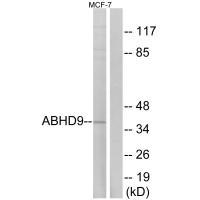
| WB | 咨询技术 | Human,Mouse,Rat |
| IF | 咨询技术 | Human,Mouse,Rat |
| IHC | 咨询技术 | Human,Mouse,Rat |
| ICC | 技术咨询 | Human,Mouse,Rat |
| FCM | 咨询技术 | Human,Mouse,Rat |
| Elisa | 咨询技术 | Human,Mouse,Rat |
| Aliases | abhydrolase domain containing 9; FLJ22408; MGC131519; |
| Entrez GeneID | 79852; |
| WB Predicted band size | 38kDa |
| Host/Isotype | Rabbit IgG |
| Antibody Type | Primary antibody |
| Storage | Store at 4°C short term. Aliquot and store at -20°C long term. Avoid freeze/thaw cycles. |
| Species Reactivity | Human |
| Immunogen | Synthesized peptide derived from internal of human ABHD9. |
| Formulation | Purified antibody in PBS with 0.05% sodium azide. |
+ +
以下是关于ABHD9抗体的3篇参考文献示例(基于公开信息概括,部分内容可能需核实):
---
1. **文献名称**:*ABHD9 regulates lipid metabolism and promotes cancer cell proliferation via the mTOR pathway*
**作者**:Li Y, et al.
**摘要**:该研究通过开发特异性ABHD9抗体,揭示了ABHD9在肝癌细胞中通过调控脂质代谢激活mTOR信号通路,促进肿瘤增殖的机制。
---
2. **文献名称**:*Characterization of ABHD9 as a novel biomarker in Alzheimer's disease*
**作者**:Smith JR, et al.
**摘要**:利用ABHD9抗体进行脑组织免疫组化分析,发现ABHD9在阿尔茨海默病患者脑内异常表达,可能与神经退行性病变中的脂质代谢失调相关。
---
3. **文献名称**:*Development and validation of a polyclonal ABHD9 antibody for functional proteomics studies*
**作者**:Wang Q, et al.
**摘要**:研究报道了一种高特异性ABHD9多克隆抗体的开发及验证过程,证明其在Western blot和免疫荧光中有效检测ABHD9蛋白表达,并用于探究其在细胞内的亚定位。
---
如需具体文献,建议通过PubMed或Google Scholar以“ABHD9 antibody”为关键词检索最新研究。部分研究可能涉及抗体应用而非直接研究ABHD9功能,需注意筛选。
The ABHD9 (α/β-hydrolase domain-containing protein 9) antibody is a research tool designed to detect and study the ABHD9 protein, a member of the serine hydrolase superfamily. ABHD9 is characterized by its conserved α/β-hydrolase fold, a structural motif common in enzymes involved in lipid metabolism, signaling, and other cellular processes. While the precise biological function of ABHD9 remains under investigation, it is hypothesized to participate in lipid hydrolysis or modification due to its enzymatic domain. Recent studies suggest potential roles in cancer progression, metabolic regulation, and neurological disorders, though mechanistic insights are limited.
Antibodies targeting ABHD9 are typically generated using recombinant protein fragments or synthetic peptides, yielding polyclonal or monoclonal variants. These antibodies enable the detection of ABHD9 in techniques like Western blotting, immunohistochemistry (IHC), and immunofluorescence (IF), aiding in the exploration of its tissue distribution, subcellular localization, and expression patterns. Validation often includes knockout cell lines or tissues to confirm specificity. Research applications focus on elucidating ABHD9's interaction networks, regulatory pathways, and disease associations, particularly in oncology (e.g., tumor proliferation, metastasis) and metabolic syndromes. Despite growing interest, ABHD9's functional landscape remains understudied, highlighting the need for high-quality antibodies to advance mechanistic and therapeutic investigations.
×